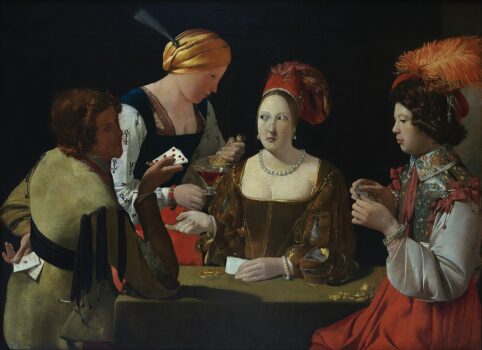The Cheat with the Ace of Diamonds: The Dangers of Trusting Appearances
In a dimly lit tavern somewhere in 17th-century France, the air is thick with smoke, wine, and the unspoken tension that hangs over a high-stakes card game. The flickering glow of a single candle dances on the polished table where four players sit. Three of them are locked in a game of skill, chance, and hidden motives. One man is about to lose more than just his coin, he’s about to lose his dignity, duped by a silent conspiracy. This is the moment forever captured in Georges de La Tour’s hauntingly enigmatic painting, The Cheat with the Ace of Diamonds.
At first glance, the scene appears elegant, even glamorous. The players are dressed in sumptuous silks and velvets, with expressions ranging from focus to coy amusement. But look closer, and the illusion of civility unravels. This is not a leisurely game. It’s a trap. And the painting, much like the game it depicts, hides more than it reveals.
Who Painted The Cheat with the Ace of Diamonds?
The Cheat with the Ace of Diamonds was painted by Georges de La Tour, a French Baroque painter renowned for his mastery of chiaroscuro, a technique that contrasts light and dark to emphasize drama and emotion. Born in 1593 in Vic-sur-Seille, Lorraine (then an autonomous duchy), La Tour’s artistic style was heavily influenced by Caravaggio and his followers, though La Tour imbued his scenes with a distinctly French sensibility: restrained, elegant, and psychologically acute.
For many years, La Tour’s name faded into obscurity after his death in 1652, overshadowed by more widely known Baroque painters like Caravaggio, Rembrandt, and Velázquez. It wasn’t until the 20th century that art historians rediscovered his work, identifying several paintings, including The Cheat with the Ace of Diamonds, as masterpieces of genre painting and psychological storytelling.
What is Happening in The Cheat with the Ace of Diamonds?
The composition is deceptively simple, featuring four figures arranged in a tight tableau. A nobleman sits at the center, absorbed in his hand of cards. Beside him, a richly dressed woman, perhaps a courtesan or accomplice, casts a glance toward a young, elaborately adorned man to her right. This man, the titular “cheat,” is in the act of slyly pulling an ace of diamonds from behind his back.
Behind the central nobleman stands a servant girl who appears innocuous, but her gaze is directed not at the cards, but at the cheat himself. Her sly smile reveals her complicity. She is likely signaling when the nobleman is distracted or when the moment is right to strike.
La Tour uses every element in the painting, costume, posture, eye contact, and gesture, to construct a narrative of deceit. The cheat, dressed flamboyantly in a feathered hat and golden doublet, embodies confidence and trickery. The woman’s revealing dress and ornamental accessories hint at seduction and manipulation. And the unsuspecting nobleman, in more modest attire, represents the naiveté of those too easily lulled by appearances.
What is the Meaning of The Cheat with the Ace of Diamonds?
This painting is more than a mere depiction of card players; it is a moral allegory. In 17th-century France, card games were often used as metaphors for life’s unpredictable nature, its blend of chance, skill, and deception. To win at cards was to master not just the rules of the game, but the human dynamics that surrounded it.
In The Cheat with the Ace of Diamonds, Georges de La Tour explores themes of deception, complicity, naiveté, and moral blindness. The nobleman, so engrossed in his hand, fails to see the trap closing around him. He is blinded by his confidence and perhaps a touch of arrogance, assuming he controls the game when in fact, he is being played.
The painting warns against the dangers of trusting appearances. Everyone around the nobleman is part of the scheme, yet they look refined, elegant, even trustworthy. It is a subtle but potent commentary on the duplicity that often hides beneath the surface of social interaction.
It also offers a critique of the upper classes, suggesting that wealth and nobility do not shield one from folly. Indeed, the very trappings of luxury may lull one into complacency, making them easy prey for those with less scruple and sharper instincts.
What Kind of Art is The Cheat with the Ace of Diamonds?
The Cheat with the Ace of Diamonds belongs to the genre of Baroque genre painting, specifically, a subgenre that deals with scenes of everyday life imbued with moral or psychological significance. Genre painting became popular in the 17th century, especially in Dutch and French art, as artists began to move away from purely religious themes and explore secular, human-centered narratives.
In terms of style, La Tour’s work also exemplifies Caravaggesque tenebrism, the use of stark light and deep shadow to heighten dramatic tension. However, unlike Caravaggio’s raw, almost theatrical intensity, La Tour’s scenes are quieter, more composed, and psychologically intimate.
Some critics and historians argue that The Cheat with the Ace of Diamonds is a kind of theatrical painting, akin to a staged scene from a play. Each character is performing a role, and the viewer becomes the unwitting audience to their drama.
Its companion piece, The Cheat with the Ace of Clubs (which is nearly identical in composition but with a slight variation in gestures and expressions), further solidifies this painting as part of a morality tale tradition, akin to medieval allegories but rendered with Baroque realism and emotional subtlety.
Symbolism and Artistic Technique
La Tour’s genius lies not just in his composition, but in his symbolic nuance. The ace of diamonds, for instance, is not just any card. In symbolic language, diamonds often represent wealth and materialism, while the ace signifies power or ambition. Thus, the ace of diamonds can be read as a symbol of greedy ambition or the corrupting allure of wealth.
The lighting in the painting also deserves special mention. The warm, directional light appears to come from a candle just out of frame, casting long shadows and creating a sense of intimacy. This technique not only adds visual drama but also mirrors the moral darkness that underlies the seemingly elegant scene.
La Tour’s attention to fabric, posture, and facial expression is meticulous. The velvet folds of the dresses, the glint of jewelry, the delicate curve of fingers holding cards, every detail serves both aesthetic and narrative purposes.
Where is The Cheat with the Ace of Diamonds Located Today?
Today, The Cheat with the Ace of Diamonds is housed in the Louvre Museum in Paris, France. It is part of the museum’s renowned collection of French Baroque art and continues to draw the admiration of scholars, students, and casual visitors alike.
Its presence in the Louvre is especially fitting, as it represents not just the brilliance of Georges de La Tour, but also the richness of French cultural and artistic heritage during the 17th century. The Louvre curators have preserved and displayed the work in a way that allows viewers to fully appreciate its psychological depth, painterly skill, and historical significance.
Why This Painting Still Resonates Today
More than 350 years after it was painted, The Cheat with the Ace of Diamonds remains startlingly relevant. In an age of misinformation, manipulation, and digital deception, the painting’s themes feel more contemporary than ever. The figures may wear ruffled collars instead of tailored suits, and their weapons may be cards rather than algorithms, but the human dynamics are the same.
We live in a world where appearances can deceive, where people often perform roles for public consumption, and where power games are played not just in casinos but in boardrooms, courtrooms, and social media feeds.
La Tour’s painting is a reminder to look beneath the surface, to question motives, and to remain vigilant in the face of seduction, whether it comes in the form of glittering jewels or smooth words.
It’s also a meditation on vulnerability. The nobleman’s downfall lies not in his lack of intelligence, but in his misplaced trust and distracted focus. In that sense, the painting invites empathy as well as caution. We’ve all been him at some point, misled, betrayed, or too absorbed in our own hands to see the larger game unfolding around us.
Georges de La Tour’s The Cheat with the Ace of Diamonds is a masterpiece that transcends time and genre. Through its elegant composition and haunting realism, it captures a moment of quiet betrayal that speaks volumes about human nature. It is a painting that invites contemplation, not just of what is seen, but of what lies beneath.
More than just a scene from a card game, it is a parable about deception, complicity, and the cost of ignorance. Its enduring power lies in its ability to mirror the subtle games we all play and the masks we all wear.
So the next time you find yourself in a room full of smiling faces, consider this painting, and ask yourself: who’s holding the ace of diamonds behind their back?




